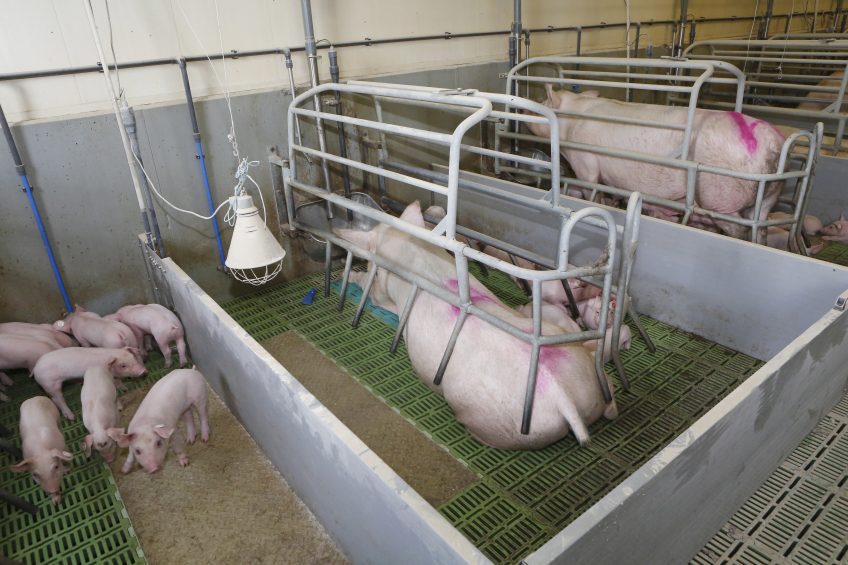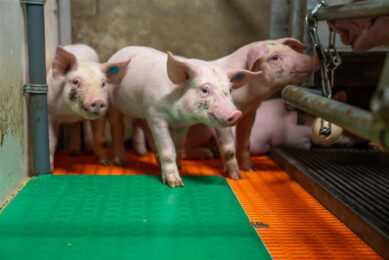Easing the stress of maternal separation

A mother’s love is a tough bond to break, so weaning can cause stress for both the sow and the piglet. However, offering piglets a gradual weaning regimen gives them both the chance to adjust slowly and with less negative consequences on performance and health in the immediate post-weaning period.
Weaning is an abrupt transition to independency that takes place at 21 to 28 days of age.
Despite efforts to familiarise piglets with creep feed during lactation, there is often large within and between litter variation in intake. A lack of familiarity with feed, in combination with other challenges such as a change in housing, maternal separation and mixing with unfamiliar piglets, generally causes a period of reduced nutrient intake immediately after weaning. A large focus has been placed on finding methods that stimulate feeding behaviour in this period to avoid a consequential reduction in growth and gastrointestinal tract (GIT) inflammation and dysfunction that generally results from underfeeding in combination with other weaning-associated stressors.
Weaning-associated stress responses
Intermittent suckling (IS), a gradual weaning regimen where a sow and her piglets are separated for specified period of time daily during the last part of lactation, mimics the increasing time a sow would spend away from her piglets under natural conditions, and has shown some evidence of improvement in post-weaning feed intake and growth in litters compared with conventional weaning. This improvement is likely mediated through increased familiarisation with creep feed as piglets are forced to explore sources of nutrition other than milk. Alternatively, habituation with maternal separation may also prevent or attenuate the weaning-associated stress response, reducing the development of altered behaviour patterns such as aggression, manipulation and a lack of play behaviour in recently weaned piglets. With an interest towards housing systems that reduce sow confinement, IS has also received renewed interest from a reproductive point of view as a potential way to mate sows during lactation rather than after weaning. Additionally, an IS regimen can be adapted to suit multi-suckling and get-away systems giving piglets opportunity to co-mingle with non-littermates, which once again mimics what would happen in nature. In a study by Weary and co-authors (2002; Appl. Anim. Behav. Sci. 76:279-290) where a get-away system with a communal piglet area was used, sows spent 14 h/d away from the piglets by the end of lactation (d 27) and piglets spent 40% of the observation time in the pens of other litters, demonstrating that maternal separation and social interaction with non-littermates will happen naturally when pigs are given a choice. Pigs weaned from such systems also generally have a higher solid feed intake after weaning and they are more likely to have positive play experiences and improved social skills, which results in better acceptance of unfamiliar pigs and reduced aggression after weaning.
2 experiments
Murdoch University, Western Australia, in collaboration with the Cooperative Research Centre for High Integrity Australian Pork, devised 2 experiments to test the hypotheses that:
- Exposure to gradual weaning (IS for 8 hours per day, 7 days before weaning)
- The mixing of non-littermate piglets during lactation (CoM of 2 litters) would reduce the stress response when piglets were mixed at weaning. This would result in improved production, behaviours and GIT absorptive capacity of selected sugars indicating enhanced welfare and improved GIT morphology and function.
In Experiment 1, a novel IS system was developed to include the opportunity for pre-weaning socialisation (CoM), where non-litter mates could interact with each other before weaning during the separation period from the sow to potentially improve social development and reduce post-weaning aggression. It was hypothesised that piglets subjected to IS (8 h separation per day for 7 d) would show better growth, higher feed intake, reduced negative behaviour patterns and reduced blood markers of inflammation, stress and lipid mobilisation supporting an increase in more feed directed behaviours before and after weaning. Intermittent suckling was applied in 2 regimens, with and without CoM (the mixing of piglets from two litters during separation), and compared with conventional weaning. It was expected that combining IS with CoM would improve post-weaning performance in an additive manner and further reduce aggressive behaviour in the immediate post-weaning period. However, since a control litter with co-mingling was not included in this study and measures of GIT morphology and function were not examined, a second experiment was designed.
In Experiment 2, IS or NoIS was applied with or without CoM to determine how IS and CoM each contribute to pre and post-weaning performance through effects on growth, feed intake, GIT absorptive capacity, behaviours, and immune, inflammatory and neuroendocrine indices compared with a conventional weaning regime. Only primiparous litters were examined in Experiment 2 since piglets born to primiparous sows seem to be the most disadvantaged at weaning.

Positive behavioural responses
Results show that the IS regime of Experiment 1 improved daily gain and daily feed intake in the immediate post-weaning period compared with conventional weaning. However, this improvement did not seem to occur through increased familiarisation with creep feed, but rather through the prevention or attenuation of the weaning-associated stress response as evidenced by increased sleeping behaviour and reduced manipulative behaviour immediately after weaning, as well as reduced post-weaning haptoglobin levels. In Experiment 2, IS reduced the plasma cortisol concentration on the day of weaning, possibly reflecting:
- the advancement of adaptive GIT changes during lactation, as supported by a reduction in galactose absorption before weaning, or
- iless stress at the time of weaning as supported by more observations of positive behaviour such as sleeping.
The addition of CoM to the IS regime also improved post- weaning performance in multiparous litters (Experiment 1), most likely due to social learning facilitating more eating before weaning and reduced aggression after weaning also reducing stress, but did not have an effect on performance with or without IS in primiparous litters (Experiment 2). Pigs that were kept in the same co-mingled groups after weaning performed the best (Experiment 1). There was strong evidence from both experiments that CoM does reduce aggression, but this did not seem to impact on selected measures of stress, inflammation or immune status. CoM also improved mannitol absorptive capacity after weaning. These results suggest that mimicking certain aspects of weaning under natural conditions, such as gradual maternal separation and the opportunity to mix with non-litter mates in lactation, can positively affect post-weaning performance and highlights opportunities for housing systems that enhance piglet welfare whilst also potentially facilitating mating in lactation.
A logical progression from the work completed in this project would be to explore a group lactation system where piglets (or sows) could be separated on a daily basis as a group to mimic the gradual nature of weaning under natural conditions. Due to the reduction of the suckling stimulus, sows may begin to cycle allowing them to be mated while still nursing their piglets. This system would allow for pre-weaning socialisation, an older weaning age and gradual weaning without the loss of sow reproductive efficiency. Alternatively, since CoM is relatively easy to implement on farms (i.e. the removal of barriers between farrowing crates rather than major changes to infrastructure), further studies examining optimal group size and methods to keep the group together after weaning could also be explored.
The research on which this article is based is from the work completed in the PhD thesis by Diana Turpin at Murdoch University (“The Gradual Weaning of Piglets: The influence of intermittent suckling and co-mingling on performance, the stress response, behaviour, and function and morphology of the gastrointestinal tract”), and from the following publications: “Intermittent suckling with or without co-mingling of non-littermate piglets before weaning improves piglet performance in the immediate post-weaning period when compared with conventional weaning”; J. Anim. Sci. Biotechnol. 8:1 and “Improving welfare and production in the peri-weaning period: Effects of co-mingling and intermittent suckling on the stress response, performance, behaviour and gastrointestinal tract carbohydrate absorption in young pigs”; Livest. Sci. 203: 82-91. This is an approved edit.











